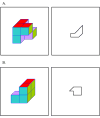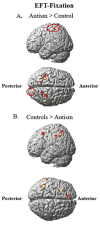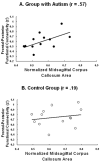Cortical underconnectivity coupled with preserved visuospatial cognition in autism: Evidence from an fMRI study of an embedded figures task
- PMID: 20740492
- PMCID: PMC2963720
- DOI: 10.1002/aur.153
Cortical underconnectivity coupled with preserved visuospatial cognition in autism: Evidence from an fMRI study of an embedded figures task
Abstract
Individuals with high-functioning autism sometimes exhibit intact or superior performance on visuospatial tasks, in contrast to impaired functioning in other domains such as language comprehension, executive tasks, and social functions. The goal of the current study was to investigate the neural bases of preserved visuospatial processing in high-functioning autism from the perspective of the cortical underconnectivity theory. We used a combination of behavioral, functional magnetic resonance imaging, functional connectivity, and corpus callosum morphometric methodological tools. Thirteen participants with high-functioning autism and 13 controls (age-, IQ-, and gender-matched) were scanned while performing an Embedded Figures Task. Despite the ability of the autism group to attain behavioral performance comparable to the control group, the brain imaging results revealed several group differences consistent with the cortical underconnectivity account of autism. First, relative to controls, the autism group showed less activation in the left dorsolateral prefrontal and inferior parietal areas and more activation in visuospatial (bilateral superior parietal extending to inferior parietal and right occipital) areas. Second, the autism group demonstrated lower functional connectivity between higher-order working memory/executive areas and visuospatial regions (between frontal and parietal-occipital). Third, the size of the corpus callosum (an index of anatomical connectivity) was positively correlated with frontal-posterior (parietal and occipital) functional connectivity in the autism group. Thus, even in the visuospatial domain, where preserved performance among people with autism is observed, the neuroimaging signatures of cortical underconnectivity persist.
Figures




Similar articles
-
Neuroimaging of the functional and structural networks underlying visuospatial vs. linguistic reasoning in high-functioning autism.Neuropsychologia. 2010 Jan;48(1):86-95. doi: 10.1016/j.neuropsychologia.2009.08.013. Neuropsychologia. 2010. PMID: 19698726 Free PMC article.
-
Functional and anatomical cortical underconnectivity in autism: evidence from an FMRI study of an executive function task and corpus callosum morphometry.Cereb Cortex. 2007 Apr;17(4):951-61. doi: 10.1093/cercor/bhl006. Epub 2006 Jun 13. Cereb Cortex. 2007. PMID: 16772313 Free PMC article.
-
The local, global, and neural aspects of visuospatial processing in autism spectrum disorders.Neuropsychologia. 2013 Dec;51(14):2995-3003. doi: 10.1016/j.neuropsychologia.2013.10.013. Epub 2013 Oct 30. Neuropsychologia. 2013. PMID: 24184351 Free PMC article.
-
Examining the characteristics of visuospatial information processing in individuals with high-functioning autism.Yale J Biol Med. 2013 Jun 13;86(2):147-56. Print 2013 Jun. Yale J Biol Med. 2013. PMID: 23766736 Free PMC article. Review.
-
Autism as a neural systems disorder: a theory of frontal-posterior underconnectivity.Neurosci Biobehav Rev. 2012 Apr;36(4):1292-313. doi: 10.1016/j.neubiorev.2012.02.007. Epub 2012 Feb 14. Neurosci Biobehav Rev. 2012. PMID: 22353426 Free PMC article. Review.
Cited by
-
Impact of methodological variables on functional connectivity findings in autism spectrum disorders.Hum Brain Mapp. 2014 Aug;35(8):4035-48. doi: 10.1002/hbm.22456. Epub 2014 Jan 22. Hum Brain Mapp. 2014. PMID: 24452854 Free PMC article.
-
Autonomy of lower-level perception from global processing in autism: evidence from brain activation and functional connectivity.Neuropsychologia. 2011 Jun;49(7):2105-11. doi: 10.1016/j.neuropsychologia.2011.04.005. Epub 2011 Apr 13. Neuropsychologia. 2011. PMID: 21513720 Free PMC article.
-
Color Vision Losses in Autism Spectrum Disorders.Front Psychol. 2017 Jun 30;8:1127. doi: 10.3389/fpsyg.2017.01127. eCollection 2017. Front Psychol. 2017. PMID: 28713324 Free PMC article.
-
Functional connectivity magnetic resonance imaging classification of autism.Brain. 2011 Dec;134(Pt 12):3742-54. doi: 10.1093/brain/awr263. Epub 2011 Oct 17. Brain. 2011. PMID: 22006979 Free PMC article.
-
A greater involvement of posterior brain areas in interhemispheric transfer in autism: fMRI, DWI and behavioral evidences.Neuroimage Clin. 2015 Apr 30;8:267-80. doi: 10.1016/j.nicl.2015.04.019. eCollection 2015. Neuroimage Clin. 2015. PMID: 26106551 Free PMC article.
References
-
- Baron-Cohen S, Hammer J. Parents of Children with Asperger Syndrome: What is the Cognitive Phenotype? Journal of Cognitive Neuroscience. 1997;9(4):548–554. - PubMed
-
- Brian JA, Bryson SE. Disembedding performance and recognition memory in autism/PDD. Journal of Child Psychology and Psychiatry. 1996;37(7):865–872. - PubMed
-
- De Jonge MV, Kemner C, van Engeland H. Superior disembedding performance of high-functioning individuals with autism spectrum disorders and their parents: The need for subtle measures. Journal of Autism and Developmental Disorders. 2006;36(5):677–683. - PubMed
-
- Hardan AY, Minshew NJ, Keshavan MS. Corpus callosum size in autism. Neurology. 2000;55(7):1033–1036. - PubMed
Publication types
MeSH terms
Grants and funding
LinkOut - more resources
Full Text Sources
Medical

